Woodland Ants
Formica rufa.
If you go into a conifer wood, where the soil is a mixture of sand and peat, you will perhaps see large mounds of pine needles anything from 3 feet up to 7 feet (approx. 2 metres) high. If these mounds appear to be moving, then tread with caution, as you have probably stumbled upon a wood ants nest. These very large ants are, in my personal opinion, the most attractive of all the native British ants.
A typical aggressive stance made by a Formica rufa worker when she is confronted by a threat, in this case a human finger.
Formica rufa is only 1 of the 4 British wood ant species; the other 3 being F. aquilonia, F. lugubris and lastly F. exsecta which is a rather smaller species than the other 3. Formica rufa is a wood ant species that can be found in the U.K. and has a two-tone body colour. The head and abdomen are dark brown, almost black; while the thorax (the bit in the middle with the legs attached to it) is a reddish orange. Studies done on wood ant species show they will hunt long distances over the forest floor, and climb the tallest trees in search of insect prey. It is not unusual to find up to 100 queens in a nest of F.rufa, while worker numbers can reach 250-300 thousand; the average nest having as least 70-100 thousand. I have stood looking at a nest of these ants, only to be driven off by hundreds of angry workers squirting formic acid all over the place. The acid smells a lot and gives off a pungent odour; but does not hurt until it gets into an open wound, which is most often caused by the ants biting with their very powerful jaws. Also be very careful not to inhale the acid fumes, as they do irritate the nose and mouth causing severe coughing and choking for a brief period. Anyone with respiratory problems such as asthma would be well advised to avoid close contact with wood ants, as their sprays of acid may well play havoc with your airways, and result in severe breathing difficulties!
The wood ants in these photos actually attacked my wife as she took their photos, and a few tried to invade her camera bag. She got bitten a few times too!


This lovely photo of Formica aquilonia adopting a defensive pose to squirt formic acid in case of a threat to the nest was taken by my good friend James O'Neill in Northern Ireland.

When a nest becomes too large, it will often expand the hunting territory by dividing or "budding" as it is better known. A group of queens and workers will move away to find a new spot to build a nest, while still having some contact with the 'mother'nest. The way a nest is made is usually to find a rotting tree stump, and then put a thatched roof of pine needles over it. This provides warmth in winter and is cool in summer. If, for any reason, the 'daughter' nest fails to flourish, or is attacked; they can retreat back to the safety of the mother nest and be welcomed back with open feelers by their sisters.
These 3 lovely photos below are of the Hairy Wood Ant, Formica lugubris. Taken by my very good friend Wes Offi at Longshaw near Sheffield, South Yorkshire.
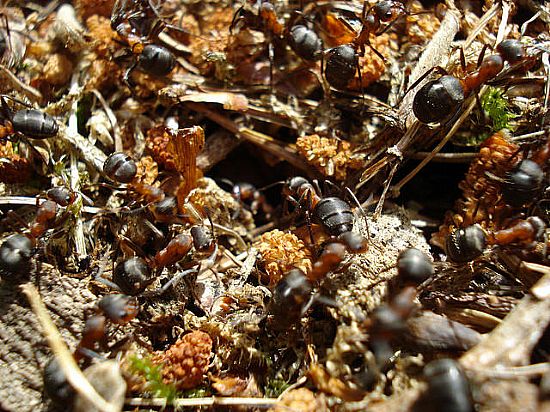
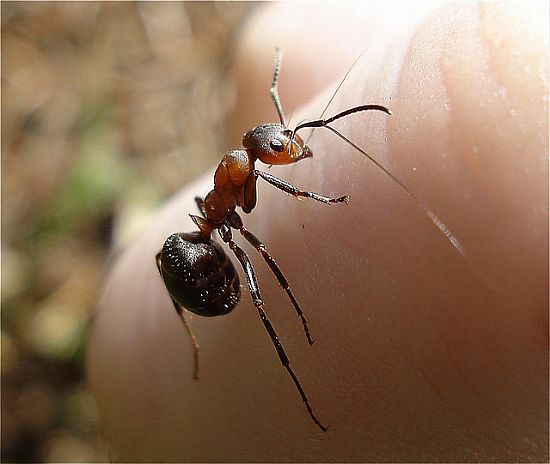
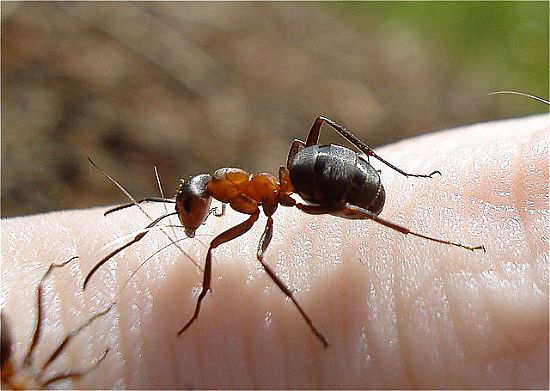
A bit of advice; if you wish to get up close and personal to a wood ants nest, say to take a photograph of them; take a tip from me! Either put your trouser leg bottoms into your socks, or wear bicycle clips. Fail to do this and you'll most definitely end up with " ANTS IN YOUR PANTS ", as they will run up your legs, and it is not much fun trying to remove an angry lot of ants who are determined to bite you on your soft vulnerable areas, like the inner thigh, or even worse. If you treat ants with some respect, you will find your encounters with them leave you relatively unscathed; which is far better for you and them! Just because your bigger, it doesn't mean you're better, does it now ?
Two wood ant workers exchange food from their crops using trophallaxis, or mouth to mouth exchange.

Nuptial Flights of Wood Ants.
I was recently e-mailed by a young member of the Ant Hill World forum which my wife runs, and as this question hasn't been brought up before, I thought I'd answer it here on my site.
The question was; "Why do wood ants have their mating flight earlier than other British ant species?"
Basically most ant queens in the UK will produce eggs in late winter, usually in February or early March. These first eggs are more often infertile, and if they not eaten, they become winged male ants. Some fertile eggs turn into female larvae which are then fed a special diet, (much like a worker bee larvae that is fed 'Royal Jelly' will become a queen bee); so the ant larvae become young alate queens, or perhaps princesses would be a more apt description, as these also come from eggs which are laid well before any worker orientated eggs appear in the nest. Wood ant species such as Formica rufa fly in mid to late June, and while I have seen alate sexuals on the surface of the nest mounds at this time of year, I sadly have never observed the actual flights of this ant; but hope to if I get lucky. Tetramorium caespitum also flies in June, though again I've never seen this happen, while Lasius alienus is perhaps the latest ant to fly here in the British Isles, flying in October; or in the event of a very bad year, not at all, in which case the sexuals are all killed in the nest prior to the onset of winter.
However, to get back to wood ants.
It is believed that young queens of Formica rufa prefer the ambient air conditions of early summer in which to fly, and the earlier a queen becomes mated, the better her chances of founding a good sized colony before the onset of the colder, wetter weather of Autumn and Winter.
Ants which fly in late Summer into early Autumn (July to September), will often do so in the heat of midday or the afternoon; although Tetramorium flies as soon as the sun is up high enough in the morning, and Formica rufa also often flies before midday if the sun has warmed up the nest mound sufficiently. Though they will also fly well into the late afternoon, as many ants tend to send out several waves of alates at different times to ensure successful matings and lessen the possibility of too many brother/sister matings so as to improve the gene pool gained from unrelated ants mating with each other. It has yet to be settled, but ants seem to use an internal clock of some kind which determines whether or not they will fly; and at which time of day or month they will do so.
Whereas many of you have probably seen a mating flight of say Myrmica or Lasius ants, Formica flights are often less seen, or on more rare occasions anyway. I have been privileged to witness the mating flights of Formica lemani when I about 17, as these flights took place in the high pasture farmland up in the hills, near to our local limestone quarry close to my home town of Macclesfield in Cheshire, which is located at the southern end of the Pennine Chain of hills in England. It is known that unlike some ant genera, Formica can and often do over-winter their sexuals, as well as producing new ones in Spring.
So, why do wood ants fly earlier than other species? Because I believe it makes sense for them to do so, as the young queens have more time to found their dynasty and create a better, bigger colony much sooner rather than later by doing so, when the conditions may be less favourable; and it also makes sense to establish a strong work force and colony bond, as a strong colony defends itself and survives far better than a weaker one any day!
A wood ant worker drinks from a droplet of honey.

Wood Ant Queens.

A wood ant queen is, without a doubt, the largest ant you are likely to ever see in any of the British ant species. She is approx. 17mm(nearly 3/4 inches) from the tips of her antennae to the tip of her gaster and stands out among her worker daughters, being such a huge size by comparison; as workers vary from 7mm to 12mm in length ! She really is a lovely creature to behold, having a reddish-brown body colour which is very shiny compared to the dullness of the workers; it shines like copper in bright sunlight, so she is very easy to see if found. Queens come to the surface of the nest in late April or early May, when the warmth of the sun has dried out the dampness of winter. They will take food from the workers, who by now have been foraging for at least the past 2 months.When they have repleted their energy after the enforced winters hibernation, egg laying begins in earnest.
Eggs laid at a temperature below 15 degrees Celcius are often infertile and will produce winged males. In fact, Formica rufa queens usually produce sexuals from the first batch of eggs laid between early February to March, through to April; only laying eggs that will produce workers at higher temperatures. This occurs from mid to late May onwards. Unlike some species, e.g. Myrmica; Formica do not seem to keep any over-wintering larvae; but make up for this by laying huge quantities of eggs in the spring, usually from April onwards into mid summer.
A colony of wood ants contains many queens. I personally found 27 queens in a nest and I'm sure there were far more than this, as large nests may contain up to 200 queens, and depending on the nest size and the species queen numbers have been estimated to reach over one thousand; but nests of this size are more rare than an average one containing usually between 100 to 150, which still reach worker numbers of around 200,000 to a 1/4 million ants. Queens are renewed or added to by young, newly fertilized females returning to the home nest, or even being found by their nest workers on foraging trips, who will drag the new queens back to the mother nest where they will join the existing queen/queens. In this way the nest gains more egg producing queens and it will grow larger in terms of worker numbers. It also means that the colonies chances of survival are greatly improved.
Formica rufa produces new colonies by budding, or sometimes a queen will enter the nest of F.fusca and become a temporary social parasite until she can usurp the host nest, after first killing the Fusca queen; the fusca workers then raise the F.rufa queens brood as if they were their own. Another wood ant, Formica polyctena has many hundreds of queens, they are smaller than F.rufa queens and they spread new colonies entirely by using the budding sytem. Budding has already been described as simply a queen, or group of queens, leaving a mother nest with some accompanying workers and forming a new nest elsewhere.
Britain's Biggest Ants.
Wood ants are found throughout Britain. Formica rufa is common in southern England and the Midlands,while further north are found her cousins, Formica lugubris and the Scottish wood ant, Formica aquilonia. All wood ant species share an ability to conserve heat within their nests, using the "thatched domes" of twigs and pine needles, just like the roof of a thatched cottage. F.rufa is the most successful group and is widespread into Wales, and up as far as Lancashire in the north of England. Wood ant workers are up to 10mm to 12mm in size.
Caring older sisters.
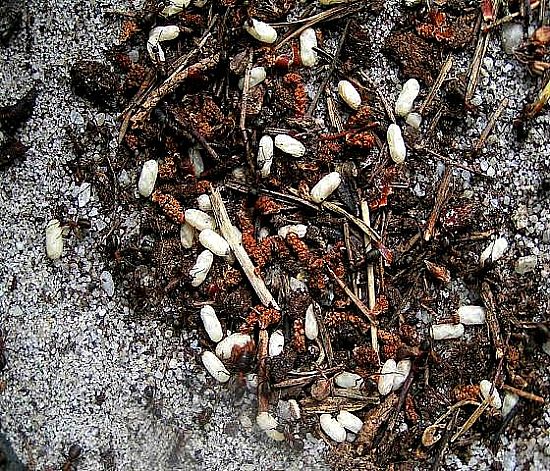
Worker ants are excellent at taking care of their, as yet, unborn sisters. Here we see nurses, rushing to put back pupae into the nest, which has been disturbed and opened the "nursery" to the elements ! The "nurse ants" will carefully pick up each and every cocoon, until they have all been removed to the safety of the nest. From these cocoons will emerge the young adult ant workers, or "callows" as they are better known as !! A callow ant is much paler in colour, and its body armour ( or Chitin, as it is called ) needs to harden; as it is very soft for the first few hours on a newly eclosed pupa ( new born ant ).
Slave Making Ants in Britain.
Formica sanguinea
Very similar in size and appearance to their woodland cousins, these ants are becoming rather rare in Britain. Strictly speaking this ant is not a wood ant, as they nest more in open sandy heathland and even their nests are not impressive mounds like say F. rufa make; but they often nest close to wooded areas and I have found their alate queens in the New Forest in Hampshire checking out F. fusca nests in forest clearings. They are also easily mistaken for wood ant workers at first glance, and are so closely related that I have decided to include them on this page.
This lovely photo of Formica sanguinea workers hunting for prey. The photo also shows some of their F. fusca "slaves" helping them. My thanks go to Rune Larsen in Denmark who took this wonderful photo, for giving me his kind permission to use it on my Ant Hill Wood site.
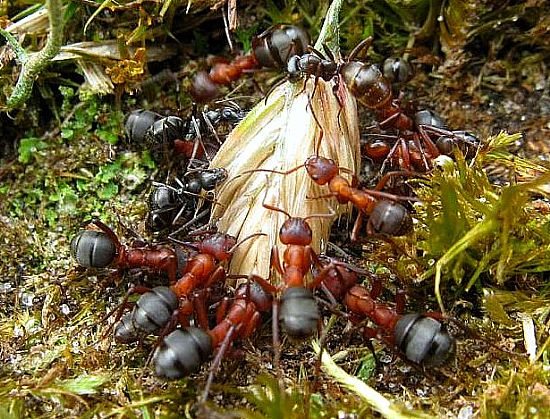
The workers are more like soldiers, in as much as they set about a raid with military precision. Once a scout has found a nest of F.fusca, it will rush back to recruit more troops from its own nest. The raiders will then surround the fusca nest and invade it. Once in, they grab as much of the fusca brood as possible; the poor fusca workers run for their lives, as they are no match for the larger sanguines, and the captive brood is carried home. Some of the captured brood will be used as food, but most will be raised into adult ants, who will join in the nest duties as though they are sanguinea workers. They will work no harder as 'slaves' as they would have done in their home nest. You may be lucky enough to see these ants if you live in the home counties of southern England, especially near sandy heathland; but don't hold your breath trying to find them, as it is very doubtful that you will unless you know exactly just what to look for?
Other, true wood ant species such as those previously mentioned in earlier chapters are more widespread throughout Britain, so you could easily catch sight of these; especially if you visit the New Forest in Hampshire, Haugh Wood in Herefordshire, or Dymock Woods in Gloucestershire; or the large forests of Scotland and the Lake District. They are also common in many northern European countries as well. Related species within the F. rufa group of ants can be found in the more northern states of the USA too, so good luck and good hunting!
Nest Mounds.

Here is a typical wood ants nest placed by a fallen tree.The black areas you can see are groups of Formica rufa workers who do this in the spring while the nest temperature is low.As it gets warmer,the ants build and repair their nest which has been damaged by winter rain and winds. The queens are still deep in the nest,but will come closer to the surface once the sun has warmed the surface in May/June. Then egg laying begins and colony life goes into overdrive until Oct/November when hibernation occurs,usually after the first frosts of early winter. The thatched nest provides protection from sun or rain and extreme temperature variations.
Excellent Hunters.
Wood ants, whichever group they belong to, are designed for hunting and foraging. I will use Formica rufa to describe this ability because I know this group well; but the same goes for the others.
If you could look at an ants head under a microscope, you would see it has 2 large faceted compound eyes. Above these, between the ants antennae, there are 3 small dots. These dots are also a type of eye called the Ocelli. They do not perform the same as the real eyes, which can see objects, movement etc; but they are very sensitive to light, especially ultra-violet. The role of the Ocelli is not fully understood, but they may serve a use in navigating the hunting trails, being used like a kind of solar compass? Ants of all species, but more so wood ants, use the Earth's magnetic field to find their way around, as an ants body is equipped with little hairs that act like sensor detectors.
Once an item of insect prey has been located, either by sight or touch/smell, it rarely gets the chance to escape. A worker wood ant will first grab the prey with her jaws, holding it firmly with her front legs. She will then squirt a jet of formic acid onto the prey, doing this several times if the prey item is large and cannot be subdued easily. When the prey is fairly comatosed (knocked out unconscious by the acid), the worker ant is then free to take it back to the nest where it will be used as food. A large nest of say 150,000 ants, which is not unusual for a wood ant colony, can collect anything from 50,000 to 70,000 insect prey per day. These ants are welcomed by the Forestry Commission as they rid huge areas of the forest floor and the trees of many harmful insect pests, which would otherwise do serious damage to our woodlands. So ants are not just excellent hunters, they are very useful in the right place !!
Wood ants are remarkable in that they actively control the temperature of their nest,as bees cool their nests with their wings.In the spring,the nest is very cold and damp;but the wood ant workers have a solution to this problem.They mass in large groups on the surface of the nest,absorbing as much warmth as they can from the sun.When their bodies are heated up from this "sun bathing",they go back into the nest so the heat can disperse.In the meantime,a fresh group of workers will "sun bathe"on the surface,until they in turn will repeat the nest warming process.It doesn't take long for the nest to reach its optimum temperature of 30degrees Celsius.Egg laying usually starts at approx.25degrees internal temperature.The nest maintains a fairly constant temperature throughout the spring and summer,despite external temperatures;and will only drop again after the first winter frost. A truly remarkable achievement for so small a creature!!!!
Anting ??
There are a group of birds called "Passerines" which use ants, not for food as you might expect; but for a completely different purpose. The bird will quite often fly down to a wood ants nest, agitate the workers so that they attack and spray formic acid, and then the bird will open up its wings and just stand there. They will even pick up a worker ant without harming it, so that they can get the ant to squirt acid into the birds feathers. Only ants that squirt formic acid are used, not the stinging variety such as Myrmica.
It is thought that the acid acts as a pesticide and rids the bird of troublesome tics and mites found in the birds plummage. Once the 'ANTING' process is finished, the bird will often go and bathe or take a sand bath if there is no water around. This is done worldwide by this group of birds. In Britain, it is commonly practised by Rooks, Starlings and Thrushes.


